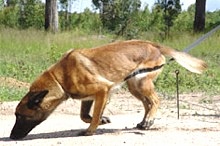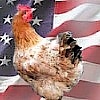   |
|
Rats are called in to defuse landmines  Zagreb - Croatia is considering using specially trained rats to help neutralise unexploded landmines left over from the 1990s Croatian-Serbian war.
Zagreb - Croatia is considering using specially trained rats to help neutralise unexploded landmines left over from the 1990s Croatian-Serbian war.A media report yesterday said that Belgium had offered to provide Croatia with the trained African rats. Rats have been described as a cheap and efficient way to remove landmines. After being released into the minefield, they sniff out the landmines and after detecting one they start to scratch the ground, alerting their handlers. "Basically, it's the same principle as with dogs, but unlike dogs, which sometimes got blown away due to their weight, rats do not have such problems and rats also do not get bored so easily," Nikola Pavkovic, an official of the Croatian Demining Centre, told a German news agency. He said the large African rats, each weighing 3kg, would first have to undergo a period of adjustment to south-eastern Europe's climate and environment. The demining rats have already been used successfully in Mozambique in a project funded by the Belgian government and the European Union. Source: Rats to sniff out landmines, Sapa-DPA, June 1, 2005 |
The GICHD Mine Dog Detection (MDD) project was implemented as independent but closely interlinked sub-activities. The aim was initially to develop international standards and guidelines, including conducting the necessary research to understand their strengths and limitations. The project has, however, evolved into something more. It also provides a focal point and a platform for cooperation between research and practice. The aims will change over time, as a direct product of current and future research results and practical experience. Although dogs are the main focus, some elements focus on alternative use of rats and chemical vapour detection. More than 20 different activities have so far been completed or are in progress. It is now clear that rats can be trained to detect landmines in the field. The economics of training and using rats operationally could be lower than for dogs. However, there is need for a proper test and validation to justify such claims, and to field test the use of rats in minefields. There is also need for further work on the potential of rats as REST detectors. The work of APOPO, a Belgian research organisation with base in Morogoro, Tanzania, is helping to identify undesired clues that animal detectors can use during the detection process. Thus APOPO will potentially help to identify essential improvements for REST dog programmes. More information about the APOPO project: Why using rats? |
|
APOPO - Rats The rodents have attractive qualities (1) A rat has a well developed sense of smell that is comparable to a dog’s. By contrast, however, rats are in general less demanding than dogs, less prone to illness and very easy to train. Also, there are animal researchers who believe to have found proof that rats can pass on trained knowledge through genetic information within a few generations. Trained to sense explosives and bred for their training to be genetically transferred, such self-reproducing explosive sensors could revolutionize the work of MgM and many others… Dogs used as Explosive Detection Dogs (EDDs) in humanitarian mine clearance have proven to be quite prone to illness and only able to work intensely for a few hours in a day. As a result, other animals that may be useful for the purpose have been (and are being) investigated. Compared with pigs, mungos, butterflies and cockroaches, MgM is convinced that especially trained laboratory rats could be a useful alternative. Of course, these animals have to be integrated into a useful chain of events – a safe operating system – you can’t just let them loose in an area where they may be mines. A South-African company, MECHEM, developed a procedure where air over a suspect area is sucked into a filter via a pump. The location where the sample originated is recorded by GPS and then the samples are analyzed thousand of kilometers away on neutral territory by explosives detecting dogs. So one dog working just a few hours a day is no longer restricted to checking 2 km of road. A dog is able to check samples that represent 20 km of road, 20 meters wide from which the samples have been taken. And several other dogs are used to check the same samples and act as a confirmation of each other’s performance. Unfortunately this revolutionary method is very expensive and labor intensive. In order to produce dependable results, the collection and separation of the air samples has to be conducted under strictly controlled and pure conditions by highly trained specialists. So the procedure and its complicated logistics cannot be easily transferred to another organizations in a different scenario. But the principle of air probes, or scent analysis could possibly be deployed successfully in another, less expensive and demanding operating system – and with other animals. In September 2001 the Management of MgM went to see the progress of the APOPO Mine Sniffing Rats Programme in Tanzania. Like with a number of other R&D projects, MgM was chosen to function as field partner for this ground breaking approach of feasible explosive vapour detection. A large number of different types of rats are bread and trained for different purposes. 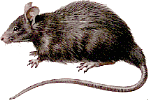 Rats
RatsThe rodents have attractive qualities (2) Different to dogs who get their drive to search for explosives out of their stimulus to play, the rewarding system with rats works via food, quite a good reason to work hard… Apopo found many ways to make rats indicate explosives, but today the project focuses on two approaches. One uses laboratory rats trained to remotely analyse vapour strips (similar to the MEDDS system), the other one trains the rodents to work in the minefield itself. MgM is the trial partner for the “free-running” rats only. The test mine field consists of hundreds of real landmines (without detonator!) of different types buried at different times at different depths. An external marking system clearly indicates the position of the mines in each box. Various systems have been trialled in order to force the animals to search the box systematically, the system MgM monitored in action showed some drawbacks in handling, but the detection rates were an astounding 100%. The rats slightly scratched the surface only and indicated this way exactly where the mines were buried. Although the achieved speed of 100 sqm in 30 minutes is substantially slower than a dog, it still remains much faster than manual (human) clearance by prodding/metal detector. Taking the costs in account, to beat the rather expensive dogs in effectiveness, one simply uses more of the relatively cheap pouch rats… Whereas these animals have proven their capacities as such, Apopo claims it will take another two years until free-running rats can be sent into MgM operations to work in parallel with the dog teams. MgM are very much looking forward to this, as it is likely to be an excellent tool for the quality control of cleared areas. Source courtesy by MgM Stiftung Menschen gegen Minen e.V. People against Landmines |
|
For Sniffing Out Land Mines, a Platoon of Twitching Noses By Michael Wines Source: The New York Times, May 18, 2004 Gondola, Mozambique — Just about every method of detecting land mines has a drawback. Metal detectors cannot tell a mine from a tenpenny nail. Armored bulldozers work well only on level ground. Mine-sniffing dogs get bored, and if they make mistakes, they get blown up. The Gambian giant pouched rat has a drawback, too: It has trouble getting down to work on Monday mornings. Other than that, it may be as good a mine detector as man or nature has yet devised. Just after sunup on one dewy morning, on a football field-sized patch of earth in the Mozambican countryside, Frank Weetjens and his squad of 16 giant pouched rats are proving it. Outfitted in tiny harnesses and hitched to 10-yard clotheslines, their footlong tails whipping to and fro, the rats lope up and down the lines, whiskers twitching, noses tasting the air. 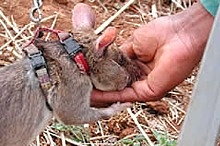 Wanjiro, a sleek 2-year-old female in a bright red harness, pauses halfway down the line, sniffs, turns back, then sniffs again. She gives the red clay a decisive scratch with both forepaws. Her trainer, Kassim Mgaza, snaps a metal clicker twice, and Wanjiro waddles to him for her reward — a mouthful of banana and an affectionate pet.
Wanjiro, a sleek 2-year-old female in a bright red harness, pauses halfway down the line, sniffs, turns back, then sniffs again. She gives the red clay a decisive scratch with both forepaws. Her trainer, Kassim Mgaza, snaps a metal clicker twice, and Wanjiro waddles to him for her reward — a mouthful of banana and an affectionate pet."What Pavlov did with his dogs is exactly what we're doing here — very basic conditioning," said Mr. Weetjens, a lanky, 42-year-old Belgian who works for an Antwerp mine-removal group named Apopo. "TNT means food. TNT means clicking sound, means food. That's how we communicate with them." Wanjiro was rewarded for sniffing out a TNT-filled land mine, one of scores buried a few inches below ground in the training field where she works out five days a week. Like all the training mines, this one was defused. But if the Mozambican authorities approve, she and her companions will move at year's end from dummies to live minefields — the world's first certified, professional mine-detecting rats. Indeed, in a test in November along a southern Mozambique railway that was heavily mined during this country's 17-year civil war, teams of three giant pouched rats found every one of 20 live mines in a previously unsurveyed 4,300-square-foot swatch of land. "Animal detection, with dogs in particular, has increased very much in the last three or four years," Havard Bach, the top expert on demining for the Geneva International Center for Humanitarian Demining, said in a telephone interview. But in many cases, he said, "it would probably be better to use rats than dogs." Rats are abundant, cheap and easily transported. At three pounds, they are too light to detonate mines accidentally. They can sift the bouquet of land-mine aromas far better than any machine. Unlike even the best mine-detecting dog or human, they are relentlessly single-minded. "Throw a stick for a dog to fetch, and after 10 times the dog will say, `Get it yourself, buddy,' " Mr. Weetjens said. "Rats will keep working as long as they want food." Plenty of work awaits them. The International Campaign to Ban Land Mines estimates that 100 million mines have been laid worldwide, from antipersonnel and antitank mines hidden underground to above-ground mines triggered by tripwires. Although Mozambique's civil war ended nearly 12 years ago, sappers here still discovered and destroyed more than 10,100 mines last year alone, and mine explosions killed or injured 14 people. Experts say the pace of land-mine detection has slowed globally in recent years, in part because the death of its celebrity spokeswoman, Lady Diana, has robbed the cause of publicity and support. But there is also a shortage of land-mine specialists, and a true dearth of sure-fire methods to find buried mines. Human detection — steel-nerved workers with metal detectors and probes — remains the preferred technique. But metal detectors are hard put to distinguish mines from other metal objects and even from some nonmetals, like mixtures of dirt and charcoal. Moreover, in areas where exploded mines have scattered metal fragments, rooting out false readings can be daunting. Dogs, with their strong noses and affinity for people, are increasingly popular; about 200 are working now in heavily mined Afghanistan. But they are hard to keep healthy, especially in tropical Africa. They tend to bond with trainers, making it hard to switch them between handlers. And they so badly want to please that a simple misreading of their trainers' body language can lead them to indicate a mine's presence where none exists or, far worse, ignore a real one. Then there are rats, which don't give a fig about people but will do anything for bananas and peanuts. "All a rat wants to do is find the target and get his reward," said Mr. Bach, of the Geneva demining center. "They're almost mechanical in the way they work." 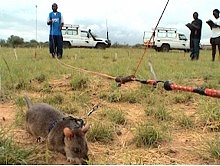 Mine-sniffing rats are the sole focus of Apopo, a Flemish acronym for "product development geared toward the demining of antipersonnel mines." The group is the brainchild of Mr. Weetjens' brother Bart; a college friend, Christophe Cox; and a University of Antwerp professor, Mic Billet, now Apopo's chairman.
Mine-sniffing rats are the sole focus of Apopo, a Flemish acronym for "product development geared toward the demining of antipersonnel mines." The group is the brainchild of Mr. Weetjens' brother Bart; a college friend, Christophe Cox; and a University of Antwerp professor, Mic Billet, now Apopo's chairman. The three decided in the late 1990's that so-called biosensor animals with great noses were the future of land-mine detection, but that there must be creatures better suited for the task than dogs. With a grant from the Belgian government, they began hunting for an animal with a dog's sense of smell, but none of its drawbacks. They approached Ron Verhagen, the head of the university's biology department, for help. "And that," Mr. Weetjens said, "is where rats came along." Specifically, along came Cricetomys gambianus, also known as the Gambian and African giant pouched rat. Up to 30 inches long, it thrives in most of sub-Saharan Africa, lives up to eight years in captivity and is "savage" in the wild, Mr. Weetjens says, but so docile when bred that some people keep them as pets. Most important, the pouched rat (so named because it stores food, hamster-style, in its cheeks) buries what it does not immediately eat and sports a nose honed to bloodhound status by eons of searching for buried food stashes. Persuading him to hunt for land mines, therefore, is as simple as convincing him that TNT is just another tasty treat waiting a few inches underground. 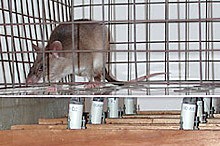 The rats' journey from farm pest to minesweeper has not been without bumps. Apopo breeds and conditions the rats to associate TNT with food at a Tanzania site run by Mr. Cox. and Mr. Weetjens's brother Marc. Then they are sent to Mozambique, where training is financed by a Belgian government grant. The first batch died en route after being accidentally left for two days on a broiling Johannesburg airport tarmac. A second batch, born in the wild, were unmanageable. "They'd bite you," Mr. Weetjens said. "They'd climb over nine-foot plexiglass walls at night, and in the morning we'd find them on the floor, fighting."
The rats' journey from farm pest to minesweeper has not been without bumps. Apopo breeds and conditions the rats to associate TNT with food at a Tanzania site run by Mr. Cox. and Mr. Weetjens's brother Marc. Then they are sent to Mozambique, where training is financed by a Belgian government grant. The first batch died en route after being accidentally left for two days on a broiling Johannesburg airport tarmac. A second batch, born in the wild, were unmanageable. "They'd bite you," Mr. Weetjens said. "They'd climb over nine-foot plexiglass walls at night, and in the morning we'd find them on the floor, fighting."But the third, home-bred batch has mostly thrived. Each rat gets to sweep a 10-by-10-meter square of land on which two defused mines or TNT scents have been hidden. Finding the mine or scent earns a click and a bite of banana or peanuts. Failure generally earns a second try. Some rats try to game the system, scratching the earth randomly in hopes of getting free treats. But the trainers feed them and sound a click to signal success only when they scratch the right spots. Bananas and peanuts, after all, are what drives giant pouched rats to excel. Which is why they are often at their worst on Monday morning. "During the week, they're on a diet; they have to work for their food," Mr. Weetjens said. "But on weekends, they get to eat as much as they want. On Mondays, they just aren't as hungry." |



